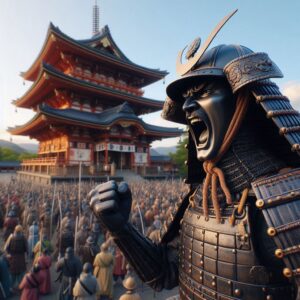敵は本能寺にありとは?
「敵は本能寺にあり」は、日本史上の有名な事件である「本能寺の変」に関連する言葉です。これは、1582年に明智光秀が主君・織田信長に対して起こしたクーデターの際に、光秀が家臣に向けて発したとされる言葉です。この言葉は、「我々の本当の標的は、本能寺にいる織田信長である」という意味を持ち、光秀が信長を討つ決意を固めた瞬間を象徴するものとして伝えられています。
現在では、表向きの目的とは異なる真の目的が別にある場合や、意外なターゲットを狙う戦略的な行動を指す言葉として使われることがあります。
「敵は本能寺にあり」の歴史的背景
本能寺の変とは
本能寺の変は、1582年6月2日に起こった事件で、明智光秀が織田信長を襲撃し、自害に追い込んだクーデターです。この事件は戦国時代の大きな転換点となり、日本史上でも非常に有名な謀反として知られています。
当時、信長は天下統一を目前にしており、京都の本能寺に滞在していました。一方で、光秀は中国地方の毛利攻めに向かうための準備をしていたと見せかけていました。しかし、突如として進軍方向を変え、家臣に「敵は本能寺にあり」と伝えて、本能寺にいる信長を急襲しました。
明智光秀の謀反の理由
光秀がなぜ信長を裏切ったのかについては、諸説あります。以下のような理由が考えられています。
信長からの冷遇と恨み
信長は家臣に対して厳しく接することが多く、光秀も何度か叱責を受けています。特に、領地の変更や公開の場での屈辱的な扱いが光秀の心に深い傷を残したと言われています。
天下を狙う野心
光秀自身が天下統一を目指していた可能性も指摘されています。信長がいなくなれば、自らが主導権を握ることができると考えたのかもしれません。
朝廷や他の大名との密約
一説には、光秀が朝廷や他の大名と連携して信長を討つ計画を立てていたという説もあります。信長の強引な政策に不満を抱く勢力が、光秀に手を貸した可能性も考えられます。
「敵は本能寺にあり」の現代での使い方
戦略的な転換の場面
現代において「敵は本能寺にあり」という表現は、表面的な目標や競争相手があるように見えても、本当に倒すべき相手や克服すべき課題は別のところにあることを示す比喩として使われます。
例えば、ビジネスの世界では、「ライバル企業との競争に気を取られていたが、本当に注目すべきは消費者のニーズの変化だった」といった状況で、「敵は本能寺にあり」と表現することができます。
意外な方向への攻撃
また、政治やスポーツの戦略の場面でも使われることがあります。例えば、ある政治家が政敵と見られていた相手ではなく、別の勢力を攻撃するような戦略を取ったときに、この表現が用いられることがあります。
「敵は本能寺にあり」から学ぶ教訓
真の敵を見極める重要性
この言葉から学べることの一つは、目の前に見えている敵や課題だけでなく、本当に取り組むべき問題を見極めることの重要性です。多くの人が目の前の問題に気を取られる一方で、本当に解決しなければならない根本的な問題を見落としがちです。
計画的な行動の大切さ
明智光秀の謀反は、事前に周到な準備をしていたことが伺えます。現代社会においても、大きな決断をするときには十分な計画と情報収集が必要です。「敵は本能寺にあり」という言葉は、目標を達成するためには慎重な戦略と準備が欠かせないことを示しています。
「敵は本能寺にあり」という言葉は、明智光秀が織田信長を討つ決意を固めた瞬間に発せられたとされる歴史的な名言です。この言葉には、目に見える敵だけでなく、本当に対処すべき問題を見極めることの重要性が込められています。現代においても、戦略的な思考や計画的な行動の重要性を示す言葉として使われることがあります。歴史の教訓を活かし、適切な判断を下せるようにすることが大切です。
The enemy is in Honnoji” is a phrase related to a famous incident in Japanese history, the Honnoji Incident. These words are said to have been uttered by Mitsuhide Akechi to his vassals during the coup d’etat he launched against his lord, Nobunaga Oda, in 1582. These words, which mean “Our real target is Oda Nobunaga at Honnoji,” are said to symbolize the moment when Mitsuhide made up his mind to defeat Nobunaga.
Today, the term is sometimes used to refer to a different true objective than the ostensible one, or to a strategic move aimed at an unexpected target.
Historical Background of “The Enemy is at Honnoji
What is the Honnoji Incident?
The Honnoji Incident, which occurred on June 2, 1582, was a coup d’etat in which Mitsuhide Akechi attacked Nobunaga Oda and forced him to commit suicide. This incident marked a major turning point in the Warring States period and is known as one of the most famous rebellions in Japanese history.At the time, Nobunaga was on the verge of unifying the country and was staying at Honnoji Temple in Kyoto. Meanwhile, Mitsuhide pretended that he was preparing to attack Mori in the Chugoku region. However, he suddenly changed the direction of his march, told his vassals that the enemy was at Honnoji Temple, and then raided Nobunaga at Honnoji Temple.
Reasons for Akechi Mitsuhide’s Rebellion
There are various theories as to why Mitsuhide betrayed Nobunaga. The following reasons are considered.Cold treatment and resentment from Nobunaga
Nobunaga often treated his vassals harshly, and Mitsuhide was reprimanded several times. In particular, it is said that the change of territory and humiliating treatment at public appearances left deep scars on Mitsuhide’s heart.Ambition to unify the country
It has been pointed out that Mitsuhide himself may have been aiming to unify the country. He may have thought that he could take control of the country once Nobunaga was gone.Secret Agreements with the Imperial Court and Other Daimyos
One theory suggests that Mitsuhide was planning to take out Nobunaga in cooperation with the Imperial Court and other feudal lords. It is possible that forces dissatisfied with Nobunaga’s forceful policies lent a hand to Mitsuhide.How to Use “The Enemy is at Honnoji” in Modern Times
Scenes of Strategic Conversion
In modern times, the expression “the enemy is in Honnoji” is used as a metaphor to indicate that although there may appear to be a superficial target or competitor, the opponent to be defeated or the challenge to be overcome really lies elsewhere.For example, in the business world, the expression “the enemy is in Honnoji” can be used in situations such as “we were preoccupied with competition with rival companies, but what we should really focus on was the changing needs of consumers.
Attacks in Unexpected Directions
It can also be used in political and sports strategy situations. For example, when a politician adopts a strategy of attacking another force rather than his perceived political opponent, this expression is sometimes used.Lessons Learned from “The Enemy is at Honnoji
The Importance of Identifying the True Enemy
One of the lessons we can learn from this phrase is the importance of identifying the real problem to be tackled, not just the enemy or issue that we see in front of us. While many people are distracted by the problems in front of them, they tend to overlook the fundamental problems that really need to be solved.The Importance of Planned Action
Mitsuhide Akechi’s rebellion shows that he had carefully prepared in advance. Even in today’s society, sufficient planning and information gathering are necessary when making major decisions. The phrase “the enemy is in Honnoji” indicates that careful strategy and preparation are essential to achieving one’s goals.The enemy is in Honnoji” is a historical quote said to have been uttered by Mitsuhide Akechi at the moment he made up his mind to defeat Nobunaga Oda. This phrase expresses the importance of identifying not only the visible enemy, but also the problems that really need to be dealt with. Even today, the phrase is sometimes used to indicate the importance of strategic thinking and planned actions. It is important to take advantage of the lessons of history so that we can make appropriate decisions.
AIが描いた「敵は本能寺にあり」









コメント